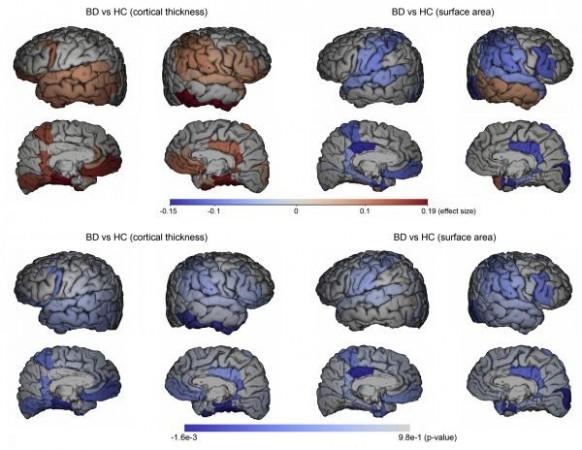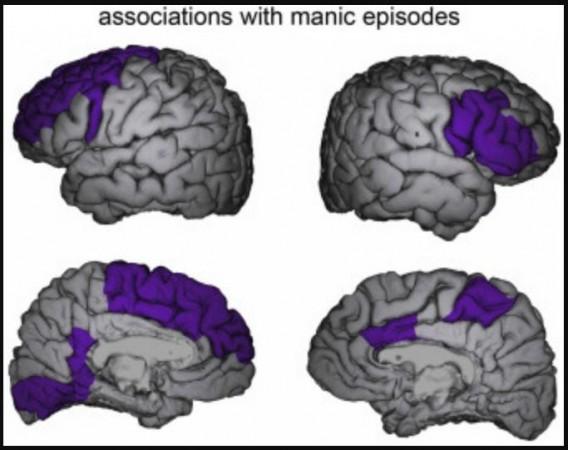There are several physical ailments that give rise to evident signs of bodily debilitation. Then, there are conditions such as psychiatric disorders that occur from within and can be equally crippling to an individual's well-being. Bipolar disorder (BD) is one such example. Now, scientists have reported that the brains of individuals with BD undergo significant changes over time.
Through a new multi-institutional study involving over 70 researchers, it was found that the cortex, the outermost layer of the brain, undergoes considerable abnormal changes over time in people with BD. It was also discovered that some of these changes were particularly associated with increased episodes of mania. The findings were published in the journal Biological Psychiatry.
"Longitudinal neuroimaging studies are extremely challenging to conduct. Here, by combining data from 14 sites, we get one of the clearest pictures we have of the neurotoxic impact of bipolar disorder, particularly manic episodes," said Dr. John Krystal, Editor of Biological Psychiatry, in a statement.
Highs and Lows

Bipolar disorder (BD) is a psychiatric disorder that causes extreme mood swings. It ranges from emotional highs (hypomania or mania) and lows (depression). Episodes of mania usually include symptoms such as high energy, feelings of exhilaration or euphoria, loss of touch with reality, decreased sleep without feeling tired, and increased talking with rapidity, among others.
Depressive episodes include symptoms such as low motivation, low energy, insomnia and sleeping problems, increased anxiety, and loss of interest in daily activities. The treatment for BP is often a combination of psychotherapy and drugs and is usually long-term.
Evaluating Changes to the Brain
Scientists have suspected for a long time that BD may also be accompanied by aberrant structural and functional changes within the brain. For the study, the authors collected detailed clinical data and magnetic resonance imaging (MRI) from 307 individuals with BD and 925 healthy controls (HC) from 14 sites across the world.

The participants were examined at two time points, ranging from six months to nine years apart. Also, the cortical thickness, surface area, and subcortical volumes of the participants were evaluated. During the course of the study, the authors compared the annualized rates of change between controls and patients with BD for each of the imaging phenotypes.
Aberrant Structural Changes
As posited, the team found significant changes to the structure of the brain. It was found that over time, the cortex thinned to a larger extent in individuals who experienced increased manic episodes. No cortical thinning or thickening was observed in people who did not have mania. Importantly, these changes were more pronounced in the prefrontal cortex (PFC), an area of the brain that is associated with the regulation of emotions and executive control.

"The fact that cortical thinning in patients related to manic episodes stresses the importance of treatment to prevent mood episodes and is important information for psychiatrists. Researchers should focus on better understanding the progressive mechanisms at play in bipolar disorder to ultimately improve treatment options," stressed Dr. Mikael Landén, senior author of the study.
New Clues to Understanding BD
In comparison to control participants, rapid enlargement of the brain's ventricles—a network of cavities within the brain containing cerebrospinal fluid—was noted in individuals with BD. However, when it came to the cortical areas outside the PFC, participants with BD exhibited slower thinning than the controls.

"The abnormal ventricle enlargements and importantly the associations between cortical thinning and manic symptoms indicate that bipolar disorder may in fact be a neuroprogressive disorder, which could explain the worsening of bipolar symptoms in some patients," explained Dr. Christoph Abé, lead author of the study.
According to the authors, one of the potential explanations for cortical thickening in patients with BD could be the use of lithium, a medication used to treat the condition. Lithium is known to possess neuroprotective effects and may improve cortical thickness. Nevertheless, the study offers crucial insights into the gradual structural changes of the brain that can help provide a better understanding of the effects of BD.

















